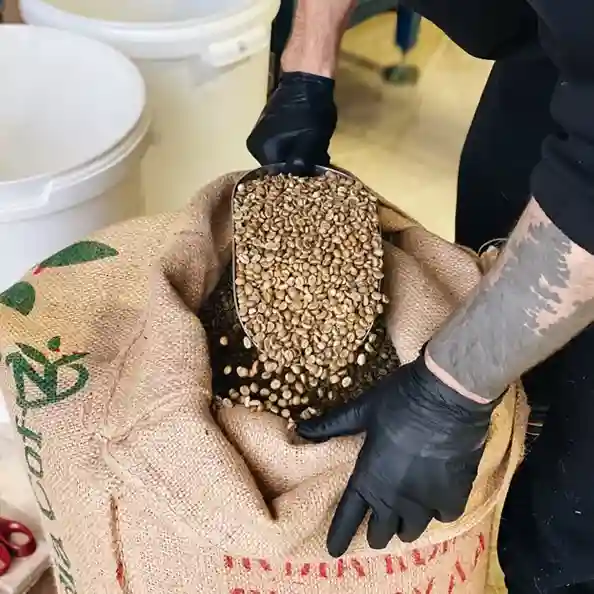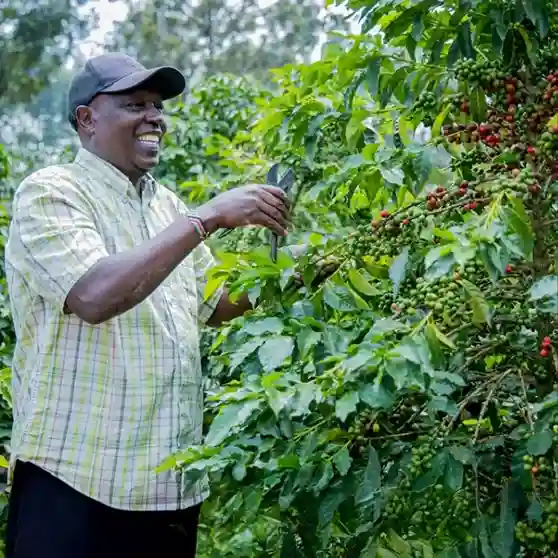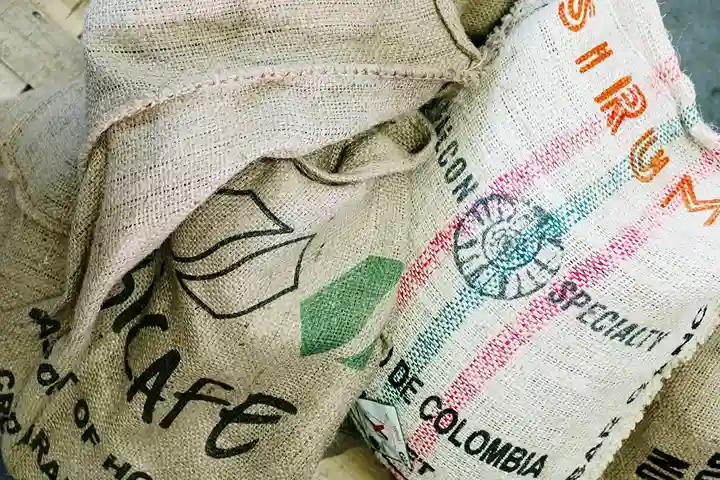The humid mountain valleys of Colombia, the red soils of Ethiopia, the vast plantations of Vietnam – all these are not just landscapes, but natural conditions that shape the taste of a cup. Knowing where the grain comes from makes it easier to feel its language of flavor.
Coffee trees grow in the so-called tropical belt, between the Tropic of Cancer and the Tropic of Capricorn. Most of the global harvest is born in this narrow geographical circle. Temperature, humidity, altitude – every climatic nuance affects the chemical composition of the beans.
Each cultural center, Brazil, Vietnam, Colombia, Ethiopia, has its own handwriting. The origin of coffee beans is not only about the place of birth of the beans. It’s also about meaning, transparency, and the connection between the farmer and the consumer who brews their drink thousands of kilometers away. For the industry, it is a reputation. For the consumer, it is a way to make an informed choice. And it starts with understanding the geography of coffee.

Geography of the coffee strip
The coffee belt is a strip of land that covers the tropical regions between the Tropic of Cancer and the Tropic of Capricorn. It is here that the climate allows for sustainable and large-scale cultivation of beans. This band covers parts of South and Central America, Africa, Asia, and the Pacific Islands.
The legume tree is capricious. It needs stable temperatures (15 to 25 °C), regular rainfall, fertile soil, and shade. Altitude also matters: at higher altitudes, the flavor of the fruit is more subtle and intense.
Traditionally, coffee is grown in three main regions:
- Latin America. Arabica with bright acidity and light body dominates here.
- Africa, especially Ethiopia and Kenya, where the berry has fruity and floral notes.
- Asia and the Pacific: Indonesia, Vietnam, India. This is where coffee beans with earthy deep shades are born, and where Robusta grows.

Countries of production: TOP-7 leaders in coffee production in the world
The space of your favorite product is multi-voiced. Each cup has its own accent, rhythm, and flavor. More than seventy countries grow trees with aromatic fruits, but it is these seven that keep the planet in good shape.
Brazil is the undisputed leader among coffee-producing countries, having made agriculture a part of its national character. Vast plantations, automated harvesting, and dozens of climatic zones allow Brazil to export the largest amount of coffee in the world. Its fruit is soft, with notes of chocolate and nuts. This is a classic that is appreciated by both big brands and intimate independent roasters who work not for volume, but for quality and character – each roaster puts his or her own vision and taste into the bean.
The Asian robusta giant Vietnam is the second largest producer of robusta in the world, focusing on strong, full-bodied coffee with a distinctive bitterness. Robusta from Vietnam is the basis for many espresso blends and instant coffee drinks.
Colombia symbolizes consistent quality. Here, coffee is grown on mountain slopes, all work is done by hand, and often the production is family farms. Arabica from Colombia is pure, balanced, with fruity flavors and delicate acidity.
Indonesia is an archipelago of flavors. Sumatra, Java, Sulawesi – each island has its own character. Full-bodied, earthy, spicy flavors prevail here. The unique wet processing gives them depth and a smoky hue.
Ethiopia. The legend and the beginning. It is here, according to legend, that a shepherd first noticed the strange influence of the tree berries. Ethiopian coffee is complex, with floral and wine notes.
Honduras is a leader in Central America. Over the past decades, the country has significantly changed its focus from volume to quality, becoming a prominent player in the specialty coffee market. The fruit native to Honduras is aromatic, with notes of caramel, tropical fruits and spices.
In India, coffee beans ripen in the shade of trees along with spices, which gives them a unique flavor. A special place is occupied by wet-roasted Arabica with a deep, mild flavor.

Regional peculiarities of coffee flavor
African coffee
Africa is vibrant, energetic, and characterful.
Each country in Africa, the birthplace of coffee, has its own unique style.
Ethiopian beans impress with their complexity of flavor: from floral and citrus notes to wine and berry tones. Beans from the Sidamo, Yergachef and Limu regions are especially popular. It is light, ethereal, with a clean aftertaste. The processing can be washed or natural, which further expands the flavor spectrum.
Kenyan Arabica is bright, juicy, with notes of black currant, grapefruit, and sometimes tomato acidity. Highland plantations and careful processing make it one of the most recognizable in the world. The sourness is not masked, but plays a major role.
Rwanda and Uganda are less well known as coffee producing regions, but their products are worthy of attention. Rwandan coffee has a mild, fruity profile with a sweet finish. Uganda predominantly grows Robusta, but also Arabica, for example in the Mount Elgon region, with notes of chocolate and spices.

Central and South America
This region is about harmony, depth and a long aftertaste.
Fruit from Latin America is considered a reference for its purity, balance and predictability of flavor. However, these classics are different for each region, depending on the soil, altitude, and climatic conditions.
Colombia is associated with highland arabica. The plantations are located on the slopes of the Andes Mountains. Stable temperatures and rich soils create ideal growing conditions. Colombian Arabica is pure, with light fruity notes, caramel, and nutty hints.
Costa Rica is known for its volcanic soils and precise quality control. Its products are brighter, with noticeable acidity and citrus or honey flavors.
Guatemala is all about depth and spicy flavor. Fruit from the Antigua and Huehuetenango regions has a rich flavor with notes of dark chocolate, cinnamon, and smoke.
El Salvador gives connoisseurs beans with a mild sweet profile and hints of caramel, almonds, and red plum. It is often used in espresso blends.
But Jamaican Blue Mountain is a real delicacy. It grows at a limited altitude with a foggy climate. Its delicate acidity, creamy texture, and delicate fruit flavor make it one of the most expensive varieties in the world.

Asia-Pacific: depth, spices and ocean winds
This region is about texture, depth and warm, rich tones. It is dominated by full-bodied profiles with low acidity, which are perfect for espresso and coffee with milk.
Indonesia’s most famous coffees come from three main islands: Sumatra, Java and Sulawesi.
Due to the traditional processing method, Indonesian coffee has a unique earthy, spicy flavor profile with notes of wood, tobacco and dark chocolate.
- Sumatra is famous for its soft, thick coffee with “wild” energy – a deep earthy and spicy flavor and a powerful aftertaste.
- Java gives a more balanced cup with notes of spices and a light grassy tone.
- Sulawesi offers a rich, syrupy texture with notes of dark cocoa and spice.
India is one of the few regions. Coffee is grown here in the shade of pepper and vanilla trees. The most famous is Monsooned Malabar, whose beans are exposed to monsoon winds after harvest. As a result, they lose their acidity and acquire a creamy and salty-spicy flavor.
Hawaii gives us rare Arabica beans with extraordinary mildness. The climate here is stable, which allows us to grow premium quality coffee. The taste is characterized by hints of nuts, milk chocolate and light citrus freshness.
Five of the most famous coffee regions on the planet
The taste of coffee depends not only on the variety and processing, but also on the terroir. Some regions have become legendary, and the coffee from them is a reference, recognizable around the world. Each of these regions has its own history, climate, and flavor language.
Yergachef, Ethiopia, is one of the coffee regions in Africa. Arabica is cultivated here with bright floral and citrus notes. The rich processing makes the coffee pure, ethereal, and complex.
Tarrazu, Costa Ricais a highland region with volcanic soils. The coffee fruit harvested here, with its high acidity, bright fruit notes, clean body and honeyed finish, is often called the “champagne of coffees.”
Sumatra, Indonesia, is a region with a unique wet hulling method that gives the beans earthy, spicy, smoky hues. The coffee is dense, deep, with a long aftertaste.
Vila, Colombia. High mountain plantations produce coffee beans with an excellent balance of acidity and sweetness, with notes of red apple, caramel and a light spicy accent.
Santa Ana, El Salvador – the region is known for its clean, balanced profiles with nutty, chocolate and mineral-fruit nuances.
Factors that affect the taste of coffee
The taste of coffee is the result of many interrelated factors. All the subtleties of flavor that we experience in a cup are formed at the cultivation stage, long before roasting or brewing.
One of the key factors is terroir, a concept borrowed from winemaking. It is a combination of soil, climate, humidity, sunshine, and even wind. For example, Costa Rica’s volcanic soils give berries a bright acidity, while Jamaica’s fogs soften the flavor.
The height of cultivation is equally important. The higher the plant grows (usually at an altitude of 1200 to 2000 meters), the slower the berry ripens, accumulating more sugars and acids. Such coffee beans have a more complex flavor profile, often with fruity and wine-like notes.
Processing methods also shape character. Washed coffee is usually clean and bright, natural coffee is sweet and rich, and honey processing combines elements of both.
Arabica is delicate, soft and has a complex profile. Depending on the region of production, the berries can exhibit different levels of acidity, from light citrus notes to brighter fruit accents. Creamy or honeyed hints add depth and sweetness to the drink, making it pleasant and harmonious.
Robusta, on the other hand, has a simpler, yet distinct character. Its flavor is characterized by astringency, bitterness, and earthy or woody notes. The high caffeine content gives it strength and sharpness, making robusta popular in strong blends and espresso.

How to choose coffee by country of origin
Choosing grains from different parts of the world, you seem to be traveling through the universe of flavors. And these flavors embody the traditions and terroirs of each region.
Africa is bright, with notes of flowers and fruits that refresh every sip.
Latin America is balanced, with light sweetness and delicate acidity.
Asia is deep and spicy, with earthy tones that add character to the drink.
Beginners are advised to start with fruits native to Latin America. These types of coffees are mild, balanced, without excessive acidity or bitterness. They open easily and are suitable for various brewing methods.
Experienced connoisseurs should experiment with African varieties, the complexity and brightness of which will definitely add new impressions. It will also be interesting to try Indonesian and Indian varieties with deep spicy notes.
When choosing beans by origin, pay attention not only to the country, but also to the specific region and method of processing the beans. This will help you find the exact shades that will inspire you every morning.

Coffee production. Trends
Climate change is having a major impact on sustainable processes. Rising temperatures, uneven precipitation, frequent droughts and floods are making it difficult to grow coffee in traditional areas. This forces farmers to look for new altitudes, adapt varieties, and sometimes move plantations to less familiar locations.
However, despite the constant challenges, coffee production in the world is growing and developing.
The top positions are consistently held by Brazil, Vietnam, and Colombia, which together account for more than half of all global exports.
In recent years, the demand for speckled berries, berries with distinct flavor profiles grown with special attention to terroir and processing methods, has increased rapidly. Because of this, farmers are increasingly paying attention not only to the quantity but also to the quality of the fruit.
Farms that specialize in speshelti are committed to sustainability: they preserve nature, support local communities, and provide a stable income for farmers.
The coffee culture is changing: nowadays, it is not the quantity but the uniqueness and quality of products that is valued. Production is increasingly organized with environmental and social factors in mind. Maximum attention is paid to how to preserve nature, support farmers and local communities. This approach is not just a trend, it is an ethical and responsible attitude towards people and the planet, it is respect for the traditions and culture of the region, which are the true basis of a cup of coffee. Each bean has its own story, related to the terroir, processing methods and people who take care of it. That is why coffee, no matter where it comes from, is not just a drink, but an embodiment of respect for traditions and care for nature.
Prospects for growing coffee in Ukraine
Ukraine is not traditionally associated with coffee production due to its climate, but recent years have seen interesting experiments with greenhouse cultivation. Greenhouse complexes allow you to control temperature, humidity and lighting, creating conditions close to tropical. Thus, it becomes absolutely possible to grow Arabica even in the Central European climate.
More and more Ukrainian coffee lovers are experimenting with coffee trees at home or in greenhouses. They not only grow plants but also learn processing and roasting techniques, creating mini-farms. This niche is still small, but it is growing rapidly thanks to online communities and the exchange of experience.
There is potential for the development of the industry in Ukraine, especially in the format of greenhouse cultivation and special microclimatic zones. This could become an interesting niche for small businesses, craft projects, and scientific research. At the same time, growing coffee trees in Ukraine is a challenge that requires innovation, patience, and love for the business.
Who knows, maybe very soon we will see coffee of Ukrainian origin on the shelves, unique, with character.
Conclusions: why it is important to know the origin of coffee
Each region where coffee is grown shapes its unique flavor and aroma, depending on the climate, soil, altitude, and how the beans are processed. Understanding these factors helps you to better appreciate the differences between different varieties and makes your coffee choices more informed.
Knowing about the country of origin and the region supports farmers who put a lot of effort into the quality of the product and helps preserve traditions and the environment.
For those who appreciate quality, discovering new regions is an opportunity to get acquainted with new flavors and features that cannot be reproduced artificially.
Terroir, harvest season, processing method, plant species, microclimate, rain, shade, humidity, and other factors interact to create a complex palette of flavors in each grain.
This makes every cup of coffee more interesting and deeper.





